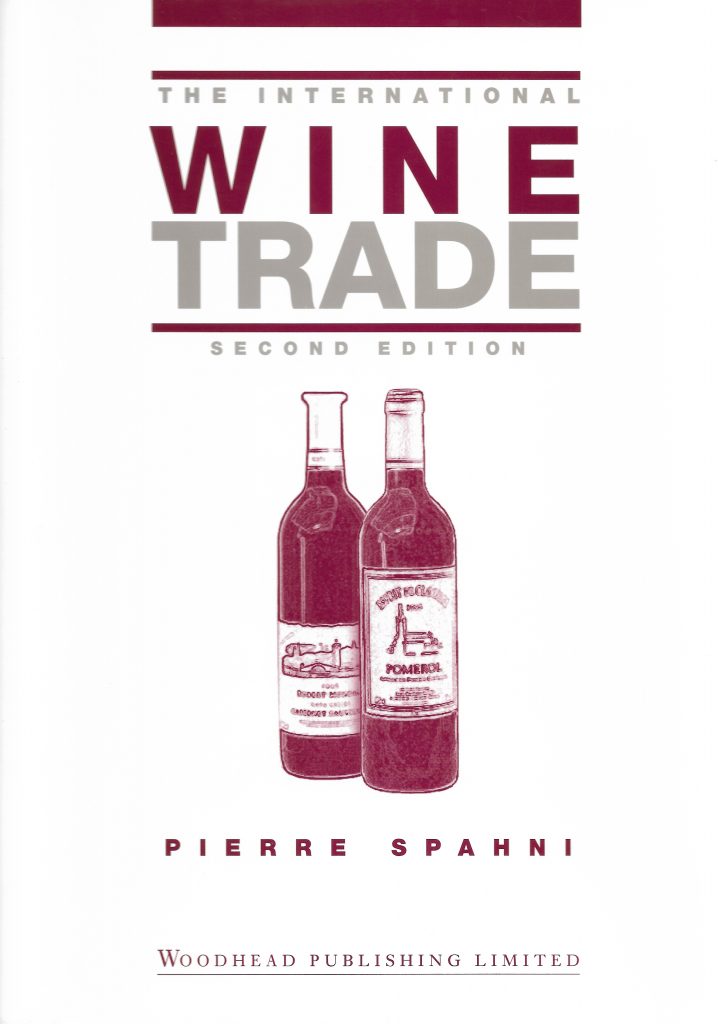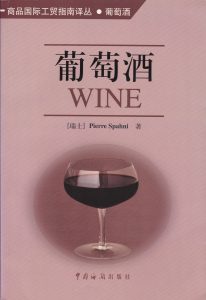THE INTERNATIONAL WINE TRADE, Second edition
Pierre Spahni, Woodhead Publishing Ltd, Cambridge UK
Sept. 2000, 395 pages, ISBN 978-1-8557-3542-2 (printed book)
ISBN 978-1-8557-3894-2 (e-book)

***
This is the second edition of the definitive analysis of the international wine trade.
This invaluable update and expansion of the first book of its kind is essential reading for wine producers, co-operatives, importers, exporters, wine merchants and retailers. It is also a key reference for policy makers, trade associations, promotional bodies, trade negotiators, financial analysts and economists.
***
The book can be obtained in various forms directly from the publisher (now part of Elsevier).
***
Also published in Chinese by China Customs Press (2003)
ISBN 978-7-8016-5062-7

***
Introduction
1. Production
Viticulture
Winemaking
The environment
Finance
Innovation
2. Consumption
Main features and trends
Traditional markets: the case of France
New markets: the British and US models
3. Prices and other trade determinants
Prices, exchange rates and costs of trading
Tariffs; excise duties and sales taxes
Technical and other legal requirements
Exports assistance
Promotional support
4. The major import markets
Japan and North East Asia
North America
Western Europe
5. Exporters’ profiles
The New World
The Old Continent
North and South Africa
6. Transition economies
Major importers
Leading exporters
Trade with the EU
7. Brave New Round
GATT’s legacy
More distant trade
A square round?
Appendix: Tariff Schedules for key markets
References
Index
The international wine trade blazed amidst a dark setting for nearly 20 years: world demand seems to have bottomed out at last, in volume terms, after two decades of general decline. The fall happened mostly in the European Union, home to the largest wine producing countries and subsidies, which nurtured a sizeable surplus over most of that time. The turnaround was caused by a slowdown in the tumbling demand by traditional markets, a reversal of a more recent contraction of consumption in the US and considerably higher growth in the new markets, particularly in Asia. The quantities of wines shipped across national borders, by contrast, have followed a generally upward trend over all those years, as have their value and average price in real terms. The most successful exporters are now based in the New World whilst those in the Old are busy upgrading their vineyards in order to regain some competitiveness abroad. But how long before the clashing views of the New and Old World – on production and marketing – degenerate into a global trade war? Will North Africa and the former Soviet bloc be left out of the deals struck by the two ‘heavyweights’ (the US and the EU) at the World Trade Organisation this time round also?
These are a few critical questions which have sprung up since the launch of the book’s first edition in 1995 – the year that GATT’s Final Act (the Marrakesh agreement) which managed to boost world wine trade in a very significant way came into force. There remains a lot of unfinished business to be dealt with at the WTO though, particularly on subsidies and in the field of intellectual property, which have been built into that agreement and are tied to one another. The New World has invested large sums of money into its brands and hopes to push them hard around the globe, but the Europeans remain adamant on them not using names bearing any resemblance with their own geographical indications; so how fast will the parties progress at WTO? Is trade growth of the kind seen recently sustainable over the longer term anyway – or could a world surplus resurface whilst trade representatives are still busy arguing on legal technicalities?
The rapid changes that have taken place on the ground alone in the past five years would have called for a second edition of The International Wine Trade. As with the first issue, this second edition strips the wine trade to its bare economic factors and subjects the countries’ import and export flows to systematic analysis with a view to facilitating international comparisons; it also incorporates recent trends and, for the first time, examines trade between the world’s main economic regions in order to gain a better perspective on the critical issue of trade liberalisation. The book aims to increase the understanding of the dynamics of the industry and offers wine professionals a unique insight into the patterns of the international wine trade since 1970.
The book provides comprehensive coverage of technical factors in the production of wine; demand determinants and trends in the consumption of wine and other alcoholic drinks; factors promoting and inhibiting wine trade; the major importing and exporting countries; markets in transition; and the likely implications of WTO negotiations for the wine trade worldwide.
The discussion is arranged as follows: the first chapter examines technical factors giving rise to differences in pricing and in other characteristics of the wines which help position the final products. Chapter 2 deals with the forces at work behind the opposite trends in consumption revealed by traditional and Anglo-Saxon markets. An overview of the issues affecting international wine trade, particularly trade barriers, is offered in the third chapter. The fourth chapter is the most substantial and pragmatic one. The individual profiles of ten major importing countries are drawn, covering most of world trade. Trends in the consumption of alcoholic drinks, wine market and import patterns, configuration of import and distribution channels, plus the country’s trade policy: all these areas are scanned using the same procedure, so that markets can be easily compared. An expanded Chapter 5 looks at trade from a different angle and takes the exporters’ view. There, the analysis focuses on the challenge posed by New World producers to those based in Western Europe – the world’s two main strategic groups. The exports of some nine countries are reviewed in greater detail. The investigation progresses eastward in Chapter 6, to the previously planned economies of the former Soviet bloc. These countries are still treated separately from market economies, for they are still in full transition and their statistics remain of lesser quality. Major importers and exporters are dealt with separately here as well. The chapter ends with the planned integration of Eastern and Western European economies. Chapter 7 brings the discussion at trade-bloc level (featuring a 14 x 14 world trade matrix for the very first time) and looks at the issues and developments laying at the core of the present round of trade negotiations at WTO. Tariff schedules and other commitments to liberalise wine trade up until 2001, which were annexed to GATT’s Final Act by the main countries of interest, are featured in the Appendix.
September 2000
REVIEWS (of the first edition):
‘One of the few detailed analyses available in this field […] very useful […] can be recommended to both the wine expert and the beginner. The former will find an exhaustive source of information and knowledge, properly selected and organised by an economic mind, while the latter will find an excellent way to enter the fascinating world of wine.’ Margherita Scoppola, Instituto Nazionale di Economia Agraria, Rome, in European Review of Agricultural Economics.
‘For all you wine business executives out there, you will appreciate The International Wine Trade […]. This is a professional text book that covers all of the world marketing trends in wine, the financial and administrative aspects of the international trade and all the statistics, charts and graphs you will ever need to impress your boss or shareholder.’ Maurice Sullivan Wine Trader Magazine.
‘Der Autor ist bestens bekannt mit den Problemen des Weinbaus und der Vermarktung. Dieses Buch is für all jene interessant, die im internationales Weingeschäft tätig sind oder sich ganz einfach ein Bild machen wollen über diesen Aspekt des edlen Getränkes.’ Werner Koblet in Schweizerische Zeitschrift für Obst- und Weinbau.
‘It codifies so much in a changing picture and gives pattern in a mass of detail.’ Tim Hall, Principal, Scala School of Wine, London.
‘[…] truly absorbing. Wine-professionals who look for a deeper understanding of their trade will be engrossed by this book. And so will wine-amateurs who have read the romance, studied the maps, but are still drawn in deeper to the marvellous amalgam of man and nature which is wine and its worldwide culture.’ Hugh Johnson
Award by the Office international de la vigne et du vin (OIV) – the intergovernmental body for wine.
***